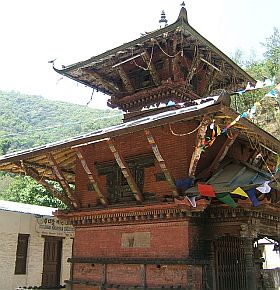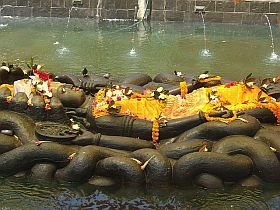Kathmandu Valley
(thomas;2010-Jul-10)
Sightseeing in the Kathmandu Valley
Besides the three famous city kingdoms in the Kathmandu valley (Kathmandu itself; Patan, also called Lalitpur; and Bhaktapur, also called Bhadgaon) and their well-trodden Durbar Squares and temples, there are many other, less well-known sights in the valley.
The first may well be the valley itself. The valley is roughly an oval, measuring 25km east to west and 20km north to south. The altitude varies mostly between 1300 and 1600m, though a few summits in the surrounding rim reach heights of more than 2700m. On a cloudless day the views extends across the whole valley (much of the cities often covered with thick layers of smog) to the pristine snow giants in the north. The valley has about 2 million inhabitants but vast tracts of land are still rural. (It always amazes first-time visitors of Kathmandu how easy it is to escape the city's noise and pollution to rural scenes which haven't changed much in several centuries, give or take the odd bus or tractor.) Anyone who spends any time in the valley should, after dutifully having done the obligatory 3-star sights (which are also extremely impressive), visit some of the rural bit and pieces.
To provide you with some ideas, here's a list of some of the less-visited highlights we find especially endearing:
 Ichangu Narayan: this two-roofed temple, a one-hour stroll west of the Stupa of Swayambunath in a small side valley, is one of the four most sacred Vishnu shrines in the Kathmandu Valley. It is dedicated to Vishnu in his Narayan incarnation. It is quite possible to continue getting up the small valley among green fields until you get to a pass from where you could continue either further up the ridge to the north or walk down the other side to catch a taxi or a bus back to Kathmandu. This walk is rural Nepal at its best.
Ichangu Narayan: this two-roofed temple, a one-hour stroll west of the Stupa of Swayambunath in a small side valley, is one of the four most sacred Vishnu shrines in the Kathmandu Valley. It is dedicated to Vishnu in his Narayan incarnation. It is quite possible to continue getting up the small valley among green fields until you get to a pass from where you could continue either further up the ridge to the north or walk down the other side to catch a taxi or a bus back to Kathmandu. This walk is rural Nepal at its best.- Changu Narayan: yet another Vishnu/Narayan temple, this one sits on a hillock to the east of Bodnath. This is one of the oldest temples in the Valley (4th century) and though it's bigger and more interesting than Ichangu Narayan the surroundings are not quite as delightful. It is easy to walk up there from the road that leads from Bodnath to Sankhu. From the temple it's possible to walk down to Bhaktapur: this used to be one of the nicest walks in the eastern half of the Valley but these days the urban sprawl of Bhaktapur lessens the pleasure somewhat.
- Chobar Gorge and Kirtipur: this gorge is one of the places where the river Bagmati which drains the Valley has broken through layers of rocks (a similar gorge is near the temples of Pashupatinath). The river can be crossed (only on foot) via an iron suspension bridge manufactured more than hundred years ago in Scotland. From the gorge it's a short walk up to Kirtipur, an old Valley town stretching along a ridge, with many temples and lots of narrow, crooked lanes. Medieval Kirtipur is perhaps the most interesting town outside the great three and well worth a visit.
- Shivapuri Peak: this is the second highest peak (2732m) of the Valley rim, located in the Shivapuri National Park, northeast of Kathmandu. The walk starts in Budhanilkantha and takes about three to four hours. Views from the summit are stupendous. There's some wildlife (mostly birds and langurs, or barking deer if you're really lucky) and lots of plants on the way. You can retrace your step or head straight south, towards the source of the holy Bagmati river and further down to Kopan monastery and the Great Stupa of Bodhnath.
- Godavari: a quiet village, nestling in the southeastern foothills of the Valley. There are the National Botanical Gardens, slightly run-down but still a cool, green godsend after a few days in hot and dusty Kathmandu. Not far from the Gardens is Godavari Kunda, a locally revered holy spring, every 12 years (next 2015) the focus of a great mela. Legend has it that this spring is connected to the Godavari river in India. There's also a famous Jesuit school, St Xavier's College which, though not really a gripping sight in itself, is interesting to visit. Godavari is also one of the starting points for the walk up Pulchowki (2762m), the highest peak of the Valley rim.
- Gokarna Mahadev: on the banks of the still young and clean Bagmati, before the river gets to the burning ghats of Pashupatinath, lies the Hindu temple of Gokarna Mahadev. This is one of the most beautiful sites in the Valley: the tranquil river location, the incredible number of sculptures around the triple-roofed temple (some more than 1000 years old), the many locals who come all day to do puja and sacrifices. The site is dedicated to Shiva: there is a famous sculpture of the god and his wife Parvati in the sensuous Uma Maheshwar position. Another statue of Parvati (dated to the 8th century) is one of the most renowned sculptures in the whole Valley. A short one-hour stroll leads from here to Kopan monastery from where you can easily return to Bodnath.
 Budhanilkantha: home to an oversized statue of a Sleeping Vishnu. This is best visited on a Saturday morning when Hindus flock to the temple and its black statue (carved from a single stone and reportedly the largest sculpture in the Valley) to pray and give sacrifices. The god is depicted as resting on the snake Ananta, before Brahma and the rest of creation starts growing out of his navel. The whole lot seems to float on the waters of a rather big pond, often covered with yellow and red flowers. This is one of our favourite sites for people watching in the whole Valley.
Budhanilkantha: home to an oversized statue of a Sleeping Vishnu. This is best visited on a Saturday morning when Hindus flock to the temple and its black statue (carved from a single stone and reportedly the largest sculpture in the Valley) to pray and give sacrifices. The god is depicted as resting on the snake Ananta, before Brahma and the rest of creation starts growing out of his navel. The whole lot seems to float on the waters of a rather big pond, often covered with yellow and red flowers. This is one of our favourite sites for people watching in the whole Valley.- Panauti: though the town of Panauti is, strictly speaking, located outside the Valley rim, it is easily reached from Kathmandu: catch a bus to Banepa, on the road to Tibet, from where it's a nice walk through mostly unspoilt countryside (there are also buses from Banepa). Panauti itself is an ancient Nepalese town which used to be a small kingdom in the days before Nepal was unified by Prithvi Narayan. Like Kirtipur, parts of it have preserved a distinctive medieval air. There is a small Durbar Square, the striking Indreshwar Mahadev temple and many smaller Hindu temples and sights. Nearby, easily reached after a two-hour stroll, is the important Buddhist pilgrimage site of Namo Buddha with its great stupa. This site also offers spectacular mountain views to the north.
If you can find it (scour the better Thamel bookshops), the 1: 50.000 Kathmandu Valley map, part of the so-called Schneider series, is a very worthwhile companion to your valley explorations. It covers the whole valley and most of the rim and is detailed enough for shorter walks and even daytrips.
$ updated from: Background.htxt Mon 28 Apr 2025 14:55:34 trvl2 — Copyright © 2025 Vero and Thomas Lauer unless otherwise stated | All rights reserved $



